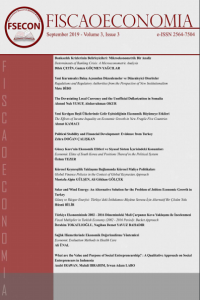Abstract
References
- KAYNAKÇA
- Çevrimiçi: Griffiths, J. (2017). CNN Cable News Network. Ocak 18, 2019 tarihinde CNN Web sitesi: https://edition.cnn.com/2016/11/02/asia/south-korea-president-scandal-explained/index.html adresinden alındı (Son Erişim Tarihi: 08.07.2019).Kim, S. (2017). BTRAX. Ocak 18, 2019 tarihinde btrax web sitesi: https://blog.btrax.com/top-10-korean-businesses-in-the-world-2015/ adresinden alındı (Son Erişim Tarihi: 08.07.2019).
- Çevrimdışı:Ahn, B.-M. (2003). Elites and Political Power in South Korea. UK: Edward Elgar.Amsden, A. H. (1989). Asia's Next Giant: South Korea and Late Industrialization. New York: New York: Oxford University Press.Chang, S.-J. (2003). Financial Crisis and Transformation of Korean Businness Groups. Cambridge: Cambridge University Press.Grajdanzev, A. J. (1944). Korea in the Postwar World. Foreign Affairs, 22(3), 479 - 483.Hasegawa, T. (2011). South Korean “Zaibatsu”: An Analysis of Its Historical and Financial Characteristics. Y. Monden içinde, South Korean “Zaibatsu”: An Analysis of Its Historical and Financial Characteristics (s. 34). Tokyo: WSPC.Kim, E. M. (1997). Big Business Strong State: Collusion snd Conflict in South Korean Development, 1960 - 1990. NewYork: State University of NewYork.Kim, E. M., Kim, J.-K., & Kim, J.-I. (2000). Restructuring of the chaebols and Financial Sestor in Korea: Progress and Assessment Since the Financial Crises. Kitakyushu: The International Centre for the Study of East Asian Development.Kim, I.-C., Kim, M.-K., & Boyer, W. W. (1994). Privatization of South Korea's Public Enterprises. The Journal of Developing Areas, 28(2), 157 - 166.Kim, S. R. (1998). The Korean System of Innovation end The Semiconductor Industry: A Governance Perspective. Industrial and Corporate Change, 7(2), 275 - 309.Kim, W. (2011). Korea's Capital Market Promotion Policies: IPOs and Other Supplementary Policy Experiences. SSRN.Korea Development Institute. (2013). The Korean Economy: Six Decades of Growth and Development. Gale Asia.Lee, J. W. (2001). The Impact of the Korean War on The Korean Economy. International Journal of Korean Studies, Spring / Summer, 97 - 118.Savada, A. M., & Shaw, W. (1992). South Korea: A Country Study. Washington D.C.: Library of Congress Federal Research Division .Steers, R. M., Shin, Y. K., & Ungson, G. R. (1989). The chaebol: Korea's New Industrial Might. New York: Harper & Row/Ballinger.Yoo, J. (2008). How Korea's Rapid Export Expansion Began in the 1960's: The Role of Foreign Exchange Rate. Korea Development Institute.
Abstract
Güney Kore, ekonomik kalkınma alanındaki başarısının yanı sıra kendine özgü bir ekonomi aktörü olan chaebollerle beraber literatürde birçok çalışmanın konusu oldu. Bu makale, Güney Kore’nin politik elitleri ile ekonomik elitleri arasındaki ilişkinin tarihsel süreç içerisinde analizini ve ekonomik elitler olan chaebolleri ekonomi politikalarını hem etkileyen hem de etkilenen bir aktör olarak tanımlamayı hedeflemektedir. Güney Kore’de Japon işgalinden sonraki bağımsızlık sürecinde devletleştirilen işletmelerin özelleştirilmesiyle chaeboller önemli oyuncular haline geldi. Kore Savaşı’nın ardından planlamacı stratejiyle ekonomik büyümenin yönlendirilmesi ve ardından ithal ikameci stratejinin yerini hem içsel hem dışsal faktörler nedeniyle ihracata dayalı büyümenin aldığı bu süreçte, ekonomik elitler politik elitlerle önce hiyerarşik sonra da yatay kabul edilebilecek bir ilişki içerisinde yer aldılar. Bu ilişkinin kurumsal mirasları kendini yeniden üreten ve bugün bile Güney Kore’nin iç ve dış siyasetine yön veren bazı özellikler taşımaktadır.
Keywords
References
- KAYNAKÇA
- Çevrimiçi: Griffiths, J. (2017). CNN Cable News Network. Ocak 18, 2019 tarihinde CNN Web sitesi: https://edition.cnn.com/2016/11/02/asia/south-korea-president-scandal-explained/index.html adresinden alındı (Son Erişim Tarihi: 08.07.2019).Kim, S. (2017). BTRAX. Ocak 18, 2019 tarihinde btrax web sitesi: https://blog.btrax.com/top-10-korean-businesses-in-the-world-2015/ adresinden alındı (Son Erişim Tarihi: 08.07.2019).
- Çevrimdışı:Ahn, B.-M. (2003). Elites and Political Power in South Korea. UK: Edward Elgar.Amsden, A. H. (1989). Asia's Next Giant: South Korea and Late Industrialization. New York: New York: Oxford University Press.Chang, S.-J. (2003). Financial Crisis and Transformation of Korean Businness Groups. Cambridge: Cambridge University Press.Grajdanzev, A. J. (1944). Korea in the Postwar World. Foreign Affairs, 22(3), 479 - 483.Hasegawa, T. (2011). South Korean “Zaibatsu”: An Analysis of Its Historical and Financial Characteristics. Y. Monden içinde, South Korean “Zaibatsu”: An Analysis of Its Historical and Financial Characteristics (s. 34). Tokyo: WSPC.Kim, E. M. (1997). Big Business Strong State: Collusion snd Conflict in South Korean Development, 1960 - 1990. NewYork: State University of NewYork.Kim, E. M., Kim, J.-K., & Kim, J.-I. (2000). Restructuring of the chaebols and Financial Sestor in Korea: Progress and Assessment Since the Financial Crises. Kitakyushu: The International Centre for the Study of East Asian Development.Kim, I.-C., Kim, M.-K., & Boyer, W. W. (1994). Privatization of South Korea's Public Enterprises. The Journal of Developing Areas, 28(2), 157 - 166.Kim, S. R. (1998). The Korean System of Innovation end The Semiconductor Industry: A Governance Perspective. Industrial and Corporate Change, 7(2), 275 - 309.Kim, W. (2011). Korea's Capital Market Promotion Policies: IPOs and Other Supplementary Policy Experiences. SSRN.Korea Development Institute. (2013). The Korean Economy: Six Decades of Growth and Development. Gale Asia.Lee, J. W. (2001). The Impact of the Korean War on The Korean Economy. International Journal of Korean Studies, Spring / Summer, 97 - 118.Savada, A. M., & Shaw, W. (1992). South Korea: A Country Study. Washington D.C.: Library of Congress Federal Research Division .Steers, R. M., Shin, Y. K., & Ungson, G. R. (1989). The chaebol: Korea's New Industrial Might. New York: Harper & Row/Ballinger.Yoo, J. (2008). How Korea's Rapid Export Expansion Began in the 1960's: The Role of Foreign Exchange Rate. Korea Development Institute.
Details
| Primary Language | English |
|---|---|
| Journal Section | Research Article |
| Authors | |
| Publication Date | September 30, 2019 |
| Published in Issue | Year 2019 Volume: 3 Issue: 3 |


